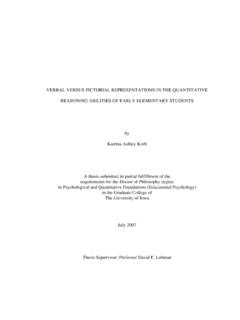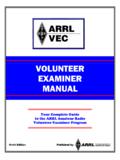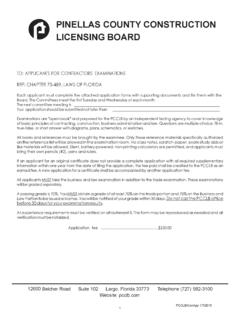Transcription of Calculating Reliability of Quantitative Measures
1 1 Calculating Reliability ofQuantitative MeasuresDr. K. A. KorbUniversity of JosReliability Overview Reliability is defined as the consistency of results from a test. Theoretically, each test contains some error the portion of the score on the test that is not relevant to the construct that you hope to measure. Error could be the result of poor test construction, distractions from when the participant took the measure, or how the results from the assessment were marked. Reliability indexes thus try to determine the proportion of the test score that is due to K. A. KorbUniversity of Jos2 Reliability There are four methods of evaluating the Reliability of an instrument: Split-Half Reliability : Determines how much error in a test score is due to poor test construction. To calculate: Administer one test once and then calculate the Reliability index by coefficient alpha, Kuder-Richardson formula 20 (KR-20) or the Spearman-Brown formula.
2 Test-Retest Reliability : Determines how much error in a test score is due to problems with test administration ( too much noise distracted the participant). To calculate: Administer the same test to the same participants on two different occasions. Correlate the test scores of the two administrations of the same test. Parallel Forms Reliability : Determines how comparable are two different versions of the same measure. To calculate: Administer the two tests to the same participants within a short period of time. Correlate the test scores of the two tests. Inter-Rater Reliability : Determines how consistent are two separate raters of the instrument. To calculate: Give the results from one test administration to two evaluators and correlate the two markings from the different K. A. KorbUniversity of JosSplit-Half Reliability When you are validating a measure, you will most likely be interested in evaluating the split-half Reliability of your instrument.
3 This method will tell you how consistently your measure assesses the construct of interest. If your measure assesses multiple constructs, split-half Reliability will be considerably lower. Therefore, separate the constructs that you are measuring into different parts of the questionnaire and calculate the Reliability separately for each construct. Likewise, if you get a low Reliability coefficient, then your measure is probably measuring more constructs than it is designed to measure. Revise your measure to focus more directly on the construct of interest. If you have dichotomous items ( , right-wrong answers) as you would with multiple choice exams, the KR-20 formula is the best accepted statistic. If you have a Likert scale or other types of items, use the Spearman-Brown K. A. KorbUniversity of Jos3 Split-Half ReliabilityKR-20 NOTE: Only use the KR-20 if each item has a right answer.
4 Do NOT use with a Likert scale. Formula: rKR20is the Kuder-Richardson formula 20 k is the total number of test items indicates to sum p is the proportion of the test takers who pass an item q is the proportion of test takers who fail an item 2is the variation of the entire testrKR20 =( )( )kk - 11 pq 2Dr. K. A. KorbUniversity of Jos I administered a 10-item spelling test to 15 children. To calculate the KR-20, I entered data in an Excel ReliabilityKR-20Dr. K. A. KorbUniversity of Jos4 This column lists each these columns, I marked a 1 if the student answered the item correctly and a 0 if the student answered +32. 7+23. 6+34. 9+15. 8+66. 7+57. 4+78. 9+29. 8+410. 5+6 Sunday1111111111 Monday1001001101 Linda1010011110 Lois1011100100 Ayuba0000011011 Andrea0111111111 Thomas0111111111 Anna0011011010 Amos0111111111 Martha0011010111 Sabina0011000001 Augustine1100010011 Priscilla1111111111 Tunde0111000010 Daniel0111111111Dr.
5 K. A. KorbUniversity of Jos The first value is k, the number of items. My test had 10 items, so k = 10. Next we need to calculate p for each item, the proportion of the sample who answered each item =( )( )kk - 11 pq 2k = 10Dr. K. A. KorbUniversity of Jos5rKR20 =( )( )kk - 11 pq 2To calculate the proportion of the sample who answered the item correctly, I first counted the number of 1 s for each item. This gives the total number of students who answered the item , I divided the number of students who answered the item correctly by the number of students who took the test, 15 in this case. StudentMath +32. 7+23. 6+34. 9+15. 8+66. 7+57. 4+78. 9+29. 8+410. 5+6 Sunday1111111111 Monday1001001101 Linda1010011110 Lois1011100100 Ayuba0000011011 Andrea0111111111 Thomas0111111111 Anna0011011010 Amos0111111111 Martha0011010111 Sabina0011000001 Augustine1100010011 Priscilla1111111111 Tunde0111000010 Daniel0111111111 Number of 1's68121271110101211 Proportion Passed (p) K.
6 A. KorbUniversity of Jos Next we need to calculate q for each item, the proportion of the sample who answered each item incorrectly. Since students either passed or failed each item, the sum p + q = 1. The proportion of a whole sample is always 1. Since the whole sample either passed or failed an item, p + q will always equal =( )( )kk - 11 pq 2Dr. K. A. KorbUniversity of Jos6rKR20 =( )( )kk - 11 pq 2I calculated the percentage who failed by the formula 1 p, or 1 minus the proportion who passed the will get the same answer if you count up the number of 0 s for each item and then divide by +32. 7+23. 6+34. 9+15. 8+66. 7+57. 4+78. 9+29. 8+410. 5+6 Number of 1's68121271110101211 Proportion Passed (p) failed (q) K. A. KorbUniversity of Jos Now that we have p and q for each item, the formula says that we need to multiply p by q for each item.
7 Once we multiply p by q, we need to add up these values for all of the items (the symbol means to add up across all values).rKR20 =( )( )kk - 11 pq 2Dr. K. A. KorbUniversity of Jos7rKR20 =( )( )kk - 11 pq 2In this column, I took p times q. For example, ( * ) = Once we have p x q for every item, we sum up these values..24 + .25 + .16 + .. + .20 = pq = +32. 7+23. 6+34. 9+15. 8+66. 7+57. 4+78. 9+29. 8+410. 5+6 Number of 1's68121271110101211 Proportion Passed (p) failed (q) x K. A. KorbUniversity of Jos Finally, we have to calculate 2, or the variance of the total test =( )( )kk - 11 pq 2Dr. K. A. KorbUniversity of Jos8 The variation of the Total Exam Score is the squared standard deviation. I discussed Calculating the standard deviation in the example of a Descriptive Research Study in side 34.
8 The standard deviation of the Total Exam Score is By taking * , we get the variance of each student, I calculated their total exam score by counting the number of 1 s they =( )( )kk - 11 pq 2 2= ProblemTotal Exam +32. 7+23. 6+34. 9+15. 8+66. 7+57. 4+78. 9+29. 8+410. 5+6 Sunday111111111110 Monday10010011015 Linda10100111106 Lois10111001005 Ayuba00000110114 Andrea01111111119 Thomas01111111119 Anna00110110105 Amos01111111119 Martha00110101116 Sabina00110000013 Augustine11000100115 Priscilla111111111110 Tunde01110000104 Daniel01111111119Dr. K. A. KorbUniversity of Jos Now that we know all of the values in the equation, we can calculate =( )( )kk - 11 pq 2k = 10rKR20 =( )( )1010 - 11 = * pq = 2= KR20 = = K. A. KorbUniversity of Jos9 Split-Half ReliabilityLikert Tests If you administer a Likert Scale or have another measure that does not have just one correct answer, the preferable statistic to calculate the split-half Reliability is coefficient alpha (otherwise called Cronbach s alpha).
9 However, coefficient alpha is difficult to calculate by hand. If you have access to SPSS, use coefficient alpha to calculate the Reliability . However, if you must calculate the Reliability by hand, use the Spearman Brown formula. Spearman Brown is not as accurate, but is much easier to + rhhrSB =2rhhwhere rhh= Pearson correlation of scores in the two half Formulawhere i2= variance of one test item. Other variables are identical to the KR-20 Alphar =( )( )kk - 11 i2 2Dr. K. A. KorbUniversity of Jos To demonstrate Calculating the Spearman Brown formula, I used the PANAS Questionnaire that was administered in the Descriptive Research Study. See the PowerPoint for the Descriptive Research Study for more information on the measure. The PANAS Measures two constructs via Likert Scale: Positive Affect and Negative Affect.
10 When we calculate Reliability , we have to calculate it for each separate construct that we measure. The purpose of Reliability is to determine how much error is present in the test score. If we included questions for multiple constructs together, the Reliability formula would assume that the difference in constructs is error, which would give us a very low Reliability estimate. Therefore, I first had to separate the items on the questionnaire into essentially two separate tests: one for positive affect and one for negative affect. The following calculations will only focus on the Reliability estimate for positive affect. We would have to do the same process separately for negative ReliabilitySpearman Brown FormulaDr. K. A. KorbUniversity of Jos10 Fourteen participants took the are the 10 items that measured positive affect on the Item Number1359101214161719154451445342533452 3454353345234544533434354355334343543653 5313233175444333443853543444539553425355 4105434344444114443344454124333133543135 5332344331432231434341 + rhhrSB =2rhhThe data for each participant is the code for what they selected for each item: 1 is slightly or not at all, 2 is a little, 3 is moderately, 4 is quite a bit, and 5 is extremely.







